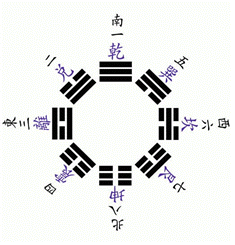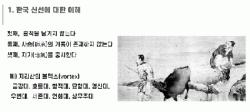학술대회논문
한국의 산신문화(The Shanshin Culture of Korea)
Davis Mason
2021년 가을 증산도문화사상 국제학술대회 논문
The Sanshin Culture of Korea
By Professor David A. Mason
Cultural Tourism Management, Sejong University, Seoul
Contents
I. Introduction to Korean Mountain-Spirits
A. Identity of the Sanshin Deity, in the Korean Cultural Context
B. Iconography of Sanshin
C. Sanshin Genders
D. Sanshin-je Ceremonies
E. The Levels of Mountain Spirits
II. The Older Style of Sanshin-gak Shrines in Buddhist Temples
III. The Emerging Style of Samseong-gak Shrines
IV. Significance Found in this Transformation
V. Conclusion: Modern Flourishing of Folk Traditions and Oriental Philosophical Concepts within Korean Buddhist Temples
ABSTRACT
For all of Korean history, the residents of this mountainous peninsula have believed that the peaks and slopes are spiritually alive, inhabited by a Sanshin [山神, Mountain-Spirit] that can be male or female, one or more per mountain, integral with it, alternatively either manifesting it or being manifested by it. Sanshin-gak [山神閣, 산신각, Mountain-spirit Shrines], are small shrines present in almost all Korean villages and Buddhist temple compounds for many centuries, containing icons of the local Sanshin. Rituals and ceremonies combining Shamanic, Buddhist and Neo-Confucian elements & factors are performed at these shrines, frequently, to venerate and propitiate the mountain’s spirit. The long tradition of iconographic representation of Sanshin within villages is an essential element of local functional social practice. Most of this presentation will focus on showing the incredible variety of artworks and shrines now found in Korea. Three important academic points are made. The first is that these Sanshin Mountain-spirits are not dying away as might be expected given Korea’s dramatic modernization, but are actually flourishing and still evolving as a “living tradition”. The second is that they are conceived, created and maintained as symbols of the relationship between human beings in communities and their local mountain, between Koreans and all their mountains; their nation. Third is that in the past two decades, Sanshin-gak are being replaced by the larger reconfigured shrine-spaces called Samseong-gak [三聖閣, 삼성각, Three Saints Shrines] containing icons of two or more related spirits; this constitutes an important and interesting step in the historical development of these spirits’ identities, reflecting their place within the complex divine hierarchy of Korean religions and also the Cheon-Ji-In [Heaven-Earth-Humanity] philosophy at their ancient root.
David A. Mason is a Professor of Korean Cultural Tourism, at Sejong University, in Seoul City, Korea. He has researched this general topic and associated vectors such as sacred mountains, geomancy, Korean religions, folklore and historic figures for 39 years by now, and the work is ongoing. He has published many previous books and articles on Korean culture and tourism include Spirit of the Mountains: Korea’s Sanshin and Traditions of Mountain-Worship (1999) and his extensive website www.san-shin.org Correspondence for this paper should be addressed to Prof. David A. Mason at mntnwolf@yahoo.com
요약
한국사를 통틀어 이 산악 반도의 주민들은 봉우리와 경사면이 영적으로 살아 있고, 남자일 수도 있고, 여성일 수도 있고 하나 또는 그 이상일 수도 있는 뗄래야 뗄 수 없는 산신(山神)이 살고 있다고 믿었다. 산신은 그 산과 봉우리를 나타내거나, 대안으로 산과 봉우리가 산신을 나타낸다.
산신각[山神閣]은 수세기 동안 거의 모든 한국 마을과 불교 사찰에 존재하는 작은 사당으로서, 지역 산신의 아이콘(icon, *도상, 상징)을 담고 있다. 산의 신령(spirit)을 공경하고 달래기 위해 무속, 불교, 성리학(Neo-Confucian) 요소와 요인을 결합한 제례와 의식이 이 사당에서 자주 거행된다.
마을 안에서 산신을 아이콘 그림(iconographic)으로 표현하는 오랜 전통은 지역의 기능적, 사회적 실천의 필수 요소이다. 이 발표의 주제 대부분은 현재 한국에서 볼 수 있는 믿을 수 없을 만큼 다양한 예술 작품과 사당을 보여주는 데 중점을 둔다. 세 가지 중요한 학문적 포인트가 논의된다.
첫째는 이러한 산신령들(Mountain-spirits)이 한국의 극적인 근대화를 감안할 때 예상되는 대로 쇠퇴하는 것이 아니라, 오히려 '살아 있는 전통'으로 실제로는 번성하고 있으며 여전히 진화하고 있다는 점이다.
둘째는 그 산신상들이 공동체 내의 인간과 그 지역의 산 사이, 한국인과 모든 산 사이의 관계를 상징적으로 잉태하고 창조하고 유지하고 있다는 것이다.
셋째, 지난 20년 동안 ‘산신각’은 둘 이상의 관련된 신령의 아이콘을 포함하는 ‘삼성각’이라고 불리는 더 크게 재구성된 사당 공간으로 대체되고 있다. 이것은 한국 종교의 복잡한 신적 위계와 고대 뿌리에 있는 천지인 철학 내에서 그들이 가지는 위치를 반영하는 이 신령들의 정체성이 역사적으로 발전하는 데 중요하고 흥미로운 단계를 구성한다.
저자 소개
데이비드 메이슨(David A. Mason) 교수는 서울에 있는 세종대학교 한국문화관광학과 교수이다. 저자는 지금까지 39년 동안 이 일반적인 주제와 신성한 산, 풍수(geomancy), 한국 종교, 민속 및 역사적 인물과 같은 연관된 지표를 연구했으며 작업을 진행하는 중이다. 저자는 한국 문화 및 관광에 관한 많은 책과 기사를 출판했다. 저서로는 『산신령: 한국의 산신과 산 숭배의 전통(1999)』이 있다.
- the sanshin culture of korea(david mason).docx (36.4KB) (38)








 댓글 0개
| 엮인글 0개
댓글 0개
| 엮인글 0개


 인쇄
인쇄 스크랩
스크랩










